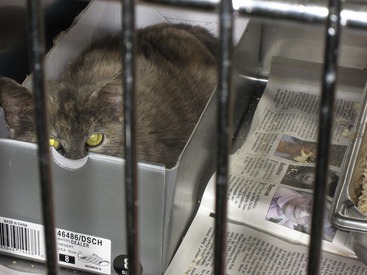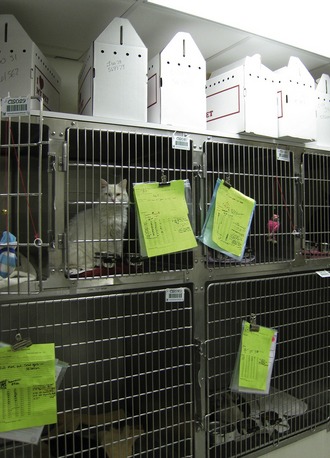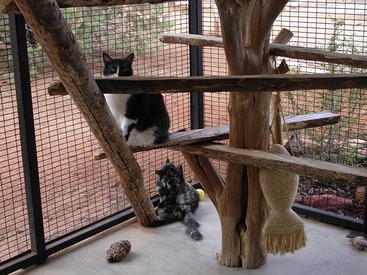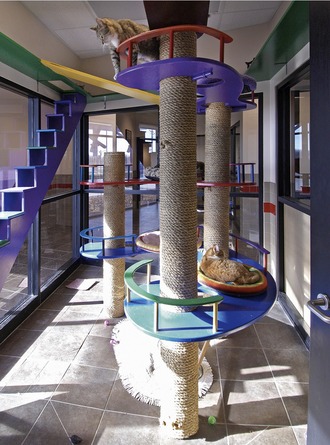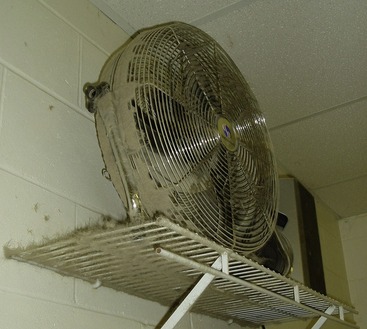CHAPTER 74 Shelter Population Health Management
Companion animal shelters continue to be a necessity for housing of free-roaming and relinquished cats. The number of cats in shelters in the United States is unknown, but it is estimated that six to eight million cats and dogs enter shelters each year.1 It also is known that in some areas of the United States, cats represent greater than 75 per cent of companion animals entering shelters, but only 2 to 5 per cent of cats entering shelters are reclaimed. A large free-roaming cat population exists in the United States and its relationship with owned and sheltered populations is unknown.2 The roles of animal shelters vary from animal control units to adoption or rehoming facilities to sanctuaries to a combination of these. Shelters may have open, limited, or closed access policies for admission depending on the shelter’s role, mission, and funding. Successful shelter population health management is dependent on the design of the facility, and the staff’s ability to minimize pathogen load and transmission; segregate populations based on health and life stage; minimize stress; afford strong preventative health care interventions; and recognize disease and provide treatment of individual animals without jeopardizing the population. Prevention of overcrowding is extremely important to maintain population health, and this can be accomplished by limiting intake when possible, utilizing strong fostering and adoption programs, and managing population density.
FACILITY AS IT RELATES TO POPULATION HEALTH
FACILITY DESIGN
The first consideration for the layout of the facility should be focused on limiting disease transmission. Many facilities being used to house populations of animals were not intended for that use. Rather, facilities are secured and modified for sheltering. These, and newly constructed facilities, should have clearly defined zones. Box 74-1 lists components of zones within shelters, identified as public and restricted.
SECURE STORAGE
Secure storage areas are needed in the restricted zone to hold foods, litter, equipment, cleaning agents and disinfectants, and other supplies. Ideally a separate area to clean and disinfect water and food dishes and litter pans, outside of animal housing rooms, should be available. Some of these areas also store food and serve as a kitchen, although some shelters utilize a mobile cart stocked with food, water, and bowls to be used during feeding times. An area to perform laundry is needed. Pest control is essential and can be achieved through securing food and eliminating waste. Intervention with traps and baits may be necessary, but caution when using chemical baits is necessary to prevent inadvertent consumption by animals in the shelter. As veterinary professionals working with shelters, we certainly can advise directors on zones, traffic control, signage, PPE, storage, and pest control. Prior to renovation or building of a shelter, professionals with experience in shelter design definitely should be consulted.3
HOUSING
Cages in the cat areas, benches, resting places, perches, and other equipment in communal areas should be nonporous so they can be cleaned and disinfected. Food bowls, litter pans, toys, and bedding should be washed and disinfected, or disposable and discarded, after use. Housing of cats in cages is essential for incoming housing, isolation, and quarantine. Segregation of cats based on life stage (e.g., nursing kittens and queens, weaning/post weaning, adolescent, and adult) is ideal because the housing and animal care needs are different as well as their immune status and function. Adoption rooms in many facilities continue to use cages. Box style cages, similar to those used in veterinary hospitals, are easy to clean and disinfect but do not meet the behavioral needs of the cats. Cages should be large enough to accommodate litter boxes and bowls with adequate distance between them, and the size of the cage should meet minimum requirements.4 Use of a vertical platform is helpful, as is a place to rest or hide, which can be as simple as a disposable shoe box or paper bag (Figure 74-1). Double-sided cages afford more space and facilitate cleaning. Cleaning with cat “in residence” or using other methods of minimizing cage moves is important to prevent stress, to prevent compromising the immune system and stimulating the recrudescence of viral pathogens. When cleaning “in residence,” the process should be restricted to cleaning of debris, and cleaning or replacement of litter boxes and feed bowls. When more thorough cleaning is needed, the use of a carrier designated for each individual cat is one method to minimize cage moves (Figure 74-2). Cleaning and disinfection of cages to prevent spread of disease should be performed between occupants.
Communal housing is being utilized more frequently in shelters to reduce stress and improve welfare.5 Animals entering communal housing, however, should be fully vaccinated, treated for endoparasites and ectoparasites, tested for feline leukemia virus (FeLV) and feline immunodeficiency virus (FIV), and free from infectious disease. Observation and removal of cats with aggressive behavior should be done routinely. Size of colonies should be limited to a maximum of 10 cats and age matching is important. Structures that can not be cleaned and disinfected easily, such as wood, should be avoided except in closed colony situations (Figure 74-3).
LIGHT AND VENTILATION
Good lighting is essential. The addition of natural light is recommended and can be provided by windows and skylights (Figure 74-4). Use of low-emission glass can protect from heat loss and gain to the building. Light fixtures should be waterproofed to protect them during cleaning. Good light quality is needed to allow for adequate cleaning. Cats require light and dark periods daily, and lights should be turned on during the day and off at night. Sound should be minimized to reduce stress on the cats and personnel.
Ventilation systems should move air effectively and be kept in good working condition with fresh air also available whenever possible (Figure 74-5). Separate ventilation systems for individual rooms, or zones, is highly recommended. Air exchange recommendations range from 8 to 15 per hour, but the energy requirements may not be affordable for many shelters. Acceptable temperature and humidity ranges are 10° to 29° C (50° to 85° F) and 10 to 50 per cent, respectively. High humidity and poor air quality caused by urine odor and chemical fumes, hair, and dust from litter, along with inadequate ventilation, may contribute to respiratory tract irritation and perhaps disease by disruption of natural mucosal barriers.
ENVIRONMENTAL INFECTION CONTROL
KNOWLEDGE OF TRANSMISSION OF PATHOGENS
Vector-borne transmission of disease to cats may occur commonly, as in the case of Dipylidium caninum transmitted by fleas. In one recent study of community-source blood donors, DNA from hemoplasma or Bartonella henselae was detected in 21.3 per cent and 22.7 per cent of the cats allowed outdoors or those with known flea exposure, respectively.6 Additionally, fleas have been proposed as a possible means of transmission of FeLV, based on detection of FeLV RNA in fleas and their feces.7 Environmental transmission occurs with pathogens that survive for extended periods of time in the environment. Route of infection may be through ingestion, direct contact, and airborne. Reproductive transmission in the shelter environment should be limited to vertical transmission during gestation or nursing. Of emerging pathogens, Group G Streptococcus canis can be transmitted to kittens born vaginally.8 Transmission of zoonoses may occur via transmission from animals to human beings or from human beings to animals. Dermatophytosis is an example of such transmission. Use of PPE helps to minimize spread to human beings as does effective treatment or control of zoonotic disease in shelters.9–10
HYGIENE PRACTICES
Contaminated hands and clothes, acting as fomites, can be a significant means of spread of disease in a shelter. Shelter staff, volunteers, and the public all may contribute. Hand washing can be one of the most effective strategies available to us in animal shelters in preventing spread of disease. Hand washing, however, does take time when done between handling of all animals and can be hard to reinforce with staff and the public. Availability of washing stations in all areas of the shelter is ideal. Signage, posted by each station, will serve as a reminder.11 When hand-washing stations are not available, use of alcohol-based hand sanitizers between handling of individual animals can be substituted if hands are not visibly dirty. Stationary units facilitate use. Not all hand sanitizers contain the same percentage or type of alcohol, making careful selection necessary. The unenveloped viruses (FPV and FCV) and dermatophytes may not be inactivated by some products.12 Efficacy studies continue to conclude that sanitizers with less than 60 per cent alcohol, although available commercially, are inferior.13 Using signs in the shelter environment, and asking the public to not touch cats without assistance from staff, may be of benefit in minimizing spread of disease. For staff, use of disposable gloves changed after handling of each cat is another consideration.
CLEANING AND DISINFECTION
Cleaning and disinfection of the shelter is necessary to maintain population health. Box 74-2 outlines a proper cleaning and disinfection protocol. Protocols should be selected, reviewed frequently, and posted to remind staff and volunteers of the protocol and its importance. Cleaning to remove dirt and organic material should be done initially. Cleaning agents then should be used on all surfaces to remove residual dirt and organic material. Following cleaning, the area should be rinsed to remove all cleaner residues and allowed to dry.
